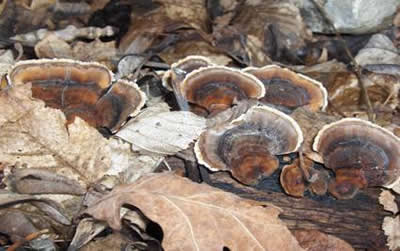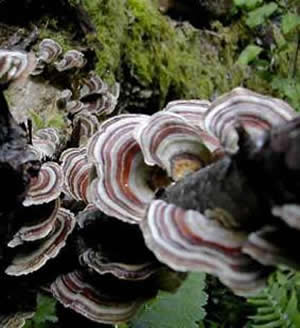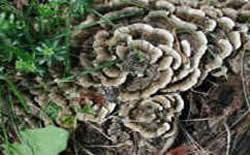Positive Health Online
Your Country

Chronic Fatigue Syndrome and Immune Modulation with Coriolus Versicolor†
listed in cfs me long covid, originally published in issue 178 - January 2011
Chronic fatigue, also referred to as myalgic encephalomyelitis, chronic viral syndrome and post viral fatigue syndrome, is a complex clinical syndrome. It is characterized by incapacitating fatigue, neurological problems and a constellation of symptoms that can resemble many other illnesses.
Definition and clinical evaluation of prolonged fatigue[1]
Prolonged fatigue is defined as self-reported, persistent fatigue of one month or longer. Chronic fatigue is defined as self-reported persistent or relapsing fatigue of six or more consecutive months.



The symptoms and signs of Chronic Fatigue Syndrome (CFS)
The symptoms include:
- Muscle pain;
- Multi-joint pain without joint swelling or redness;
- Sore throat;
- Self-reported impairment in short-term memory or concentration severe enough to cause substantial reduction in previous levels of occupational, educational, social or personal activities;
- Changes in mood;
- Headaches of a new type, pattern or severity;
- Unrefreshing sleep;
- Tachycardia;
- Coldness of the extremities;
- Sweating;
- Pallor and sluggish pupils;
- Post-exertional malaise lasting more than 24 hours.
The signs include:
- Low-grade fever;
- Non-exudative pharyngitis;
- Palpable or tender lymph nodes.
Causes of this Syndrome
Amongst the causes are post-viral disruptions of immune functions (PVS). A variety of viruses have been implicated in the development of CFS, including herpes viruses (EBV, CMV, herpes simplex and human herpes 6: HHV6), polio, Coxsackie, adenoviruses and retroviruses. Other causes may include chemical and metal exposure (e.g. pesticides and organic solvents exposure).
In patients with CFS/myalgic encephalomyelitis, the major complaint is rapid fatigability, which some doctors have linked to mitochondrial failure in CFS patients who have associated heart impairment. This is related to weak heart muscle function; thus it is possible to monitor and measure the level of CFS via an autonomic function test to check heart rate variability (HRV).
Coriolus versicolor - a Continuing Solution
Coriolus versicolor is a mushroom from the Amastigomycota group of mushrooms. This group of mushrooms is a large and diverse group that does not produce a motile stage and is not adapted to an aquatic environment. It contains all edible and medicinal fungi.
There are four subdivisions:
- Zygomycotina;
- Ascomycotina;
- Basidiomycotina;
- Deuteromycotina.
Coriolus is from the family of Polyporaceae from the Basidiomycetes group. It contains a polysaccharopeptide (PSP) which has been non-specifically used in a number of conditions to alleviate symptoms and prevent a decline in immune status.[2] The fungus Coriolus versicolor is found almost worldwide with variation due to habitat. To eliminate these variations, strain CV-OH1 was established some 20 years ago by Gourmet Mushrooms Inc, in California, USA.
Therapeutic Properties
Coriolus versicolor can enhance superoxide dismutase (SOD) activity.[3] It is thought to protect macrophages from the damage induced by reactive oxygen species by enhancing antioxidant capacity.[4] Activation of peritoneal macrophages by PSP has been shown and an immunomodulatory effect on the defensive cells was demonstrated.[5] In view of these findings, Coriolus was used for its effects on host defence potentiation.
Usage / Potency Properties
- Long term stability;
- Complies with British Pharmacopoeia (BP);
- Sterile conditions;
- No pesticides;
- No heavy metal.
This study is specifically looking at the CV-OH1 strain which demonstrates rapid and aggressive colonization and far outmatches other isolates in bioactivity and vigour. A mother culture of strain CV-OH1 has been developed and maintained since isolation and this is used to produce the spawn. In-house checks confirm that the mother culture does not move from the original isolate. The production process involves the inoculation of sterile organic edible grain with the spawn from the mother culture.
The fungus is allowed to completely colonize the growth medium aseptically and at the correct stage of development, at maximum bioavailability, the living biomass is aseptically air-dried and granulated before being tested microbiologically. This technique produces a raw material which is sterile and contains no pesticides, heavy metals, is free from foreign matter and is totally reproducible.
The material is shipped to a UK Good Medical Practice (GMP) pharmaceutical facility where it is manufactured into 500 mg tablets with the addition of cellulose, silica, a granulating agent and a tablet press lubricant. The finished tablet Coriolus MRL†† complies with the BP requirements for tablets and long-term stability is being established using TVC and PCR. This tablet was suitable to be given to CFS patients to determine the immune enhancing properties of Coriolus versicolor. A PCR/electrophoresis method is being established to determine the DNA of this product as an additional method of quality control.
In this study, CFS patients were tested with Coriolus versicolor (CV-OH1 strain 500 mg tablet) to check if the tablet would have similar immune-enhancing properties. In order to determine the therapeutic response, patients were examined for dysautonomia pre- and post-treatment.
Previous studies have reported beneficial immune-enhancing properties in vivo and in vitro, as well as preventative properties associated with antioxidant properties. These findings allow the use of Coriolus versicolor in chronic fatigue patients who all have marked autonomic dysfunction.
Natural Killer Cells[6]
We know that natural killer (NK) cells are the first line of defence against newly arising malignant cells and cells infected with viruses, bacteria and protozoa. They form a distinct group of lymphocytes with no immunological memory and are independent of the adaptive immune system.
Natural killer cells constitute 5% to 16% of the total lymphocyte population. Their specific function is to kill infected and cancerous cells. Viruses lack the apparatus for self-renewal, so it is essential for them to penetrate the cells of the infected host in order to take over its replicative machinery. It is clearly in the interest of the host to find a way to kill such infected cells before the virus has had a chance to reproduce.
NK cells appear to do just that when studied in vitro. They are large granular lymphocytes with a characteristic morphology. They are thought to recognize structures on high molecular weight glycoproteins which appear on the surface of virally infected cells, and which allow them to be differentiated from normal cells. This recognition probably occurs through lectin-like (i.e. carbohydrate-binding) receptors on the NK cell surface, which bring killer and target into close opposition.
Activation of the NK cell ensues and leads to polarization of granules between nucleus and target within minutes, and extra-cellular release of their contents into the space between the two cells, often utilizing the cytolysin [antibodies that cause the dissolution of various cells of an organism or bacterium] perforin [protein in killer cells and natural killer cells that causes lysis of target cells on contact]. NK cells kill by activating apoptosis. In addition to perforin, the granules contain tumour necrosis factor ß and a family of serine proteases termed granzymes, one of which, granzyme B, can function as an NK cytotoxic factor. Fully ionised ATP can cause apoptosis in many different cell types; the effectors themselves are resistant probably due to a lack of ATP receptors on their surface.
These factors sequentially induce NK-mediated lysis. Virally infected cells can be killed by cytotoxic T cells and ADCC [antibody-dependent cell-mediated cytotoxicity].[7]
Sample for the Study
Patients were examined and a number of the abnormal findings were recorded in patients with chronic fatigue syndrome, such as lymphadenopathy and pharyngitis. There was also disturbance of autonomic function in all patients evaluated by HRV.
The HRV test confirmed dysautonomia [malfunction of the autonomic nervous system] (statistics compiled by Dr Alexey Tarnakin). Symptoms of dysautonomia are numerous and vary widely from person to person. Dysautonomia is a full-body condition; a large number of symptoms are present that can greatly alter a person's quality of life. Each patient with dysautonomia is different: some are affected only mildly while others are left completely bedridden and disabled.
All 36 patients had HRV examination before treatment (31 standing as some were too weak for sustained standing). The results are presented in Table 1. The age range is between 17 to 83 years, with a female to male ratio of 2:1.
| Table 1 Heart Rate Variability before Treatment | ||
| Lying 36 patients |
Standing 31 patients |
|
| Mean RR | 868±156 | 774+110 |
| Minimum RR | 562 | 524 |
| Maximum RR | 1058 | 1048 |
| SDNN | 45.9 | 47.7 |
| RMSSD | 54.9 | 39.3 |
| SDSD | 54.9 | 39.3 |
| NN50 | 46.9 | 47.8 |
| pNN50 | 10.5 | 8.62 |
| Total Power of HRV 3466±1018 | 2593±954 | 2706±1420 |
| VLF | 374 | 427 |
| LF 1170±416 | 247±214 | 364±686 |
| HF 975±203 | 220±266 | 188±255 |
| LF/HF Ratio 1.5 - 2.0 | 1.76±1.25 | 3.11±2.67. |
Key:
SDNN: Standard deviation of the normal-to-normal interval
RMSSD: Square root of the mean squared differences of successive NN intervals
SDSD: Standard deviation of differences between adjacent NN intervals
NN50: Number of interval differences of successive NN intervals greater than 50 ms
pNN50: NN50 count divided by the total number of all NN intervals
VLF: Very low frequency
Summary:
The Total Power (TP) of Heart Rate Variability (HRV) was slightly decreased with a mild increase on standing.
The Low Frequency component (LF) of TP HRV and the High Frequency component (HF) of TP HRV were moderately decreased.
The LF/HF Ratio was within normal range.
On standing, there was a mild increase of LF and a mild decrease of HF with subsequent increase of LF/HF Ratio.
The individual analyses of HRV before Coriolus treatment are presented in Table 2.
| Table 2 Heart Rate Variability before Coriolus Treatment | |||||
| Lying 36 patients | Standing 31 patients | ||||
| RR less 0.67sec | RR 0.67 - 1.0 sec | RR more 1.0 sec | RR less 0.67sec |
RR 0.67 - 1.0 sec | RR more 1.0 sec |
| 2 |
28 | 6 | 4 | 25 | 2 |
| Total Power of HRV less 2000 |
Total Power of HRV 2000 - 4000 | Total Power of HRV more 4000 | Total Power of HRV less 2000 | Total Power of HRV 2000 - 4000 | Total Power of HRV more 4000 |
| 10 | 22 | 4 | 9 | 20 | 2 |
| LF less 600 | LF 600 - 1600 | LF more 1600 | LF less 600 | LF 600 - 1600 | LF more 1600 |
| 33 | 3 | 0 | 28 | 2 | 1 |
| HF less 700 | HF 700 - 1200 | HF more 1200 | HF less 700 | HF 700 - 1200 | HF more 1200 |
| 33 | 3 | 0 | 30 | 1 | 0 |
| LF/HF Ratio less 1.5 |
LF/HF Ratio 1.5 - 2.0 | LF/HF Ratio more 2.00 | LF/HF Ratio less 1.5 | LF/HF Ratio 1.5 - 2.0 | LF/HF Ratio more 2.0 |
| 19 | 4 | 13 | 8 | 6 | 17 |
Summary:
10 out of 36 patients had a decrease in the TP of HRV, 22 out of 36 patients had normal TP of HRV and 4 out of 36 patients had an increase of the TP of HRV.
LF and HF components were decreased in 33 out of 36 patients with LF/HF Ratio less than 1.5 (predominance of vagal tone) in 19 out of 36 patients and with LF/HF Ratio more than 2.00 (sympathetic predominance).
On standing, 9 out of 31 patients had a decrease of the TP of HRV, 20 out of 31 patients had normal TP of HRV and 2 out of 31 patients had an increase of the TP of HRV.
LF component was decreased in 28 out of 31 patients with LF/HF Ratio less than 1.5 (predominance of vagal tone) in 8 out of 31 patients and with LF/HF Ratio more than 2.00 (sympathetic predominance) in 17 out of 36 patients.
HF component was decreased in 30 out of 31 patients.
These results suggest a decrease of the total activity of the autonomic nervous system with altered sympathetic tone.
Tests Performed
- T-lymphocyte subsets;
- Natural killer cells : CD3-CD16+CD56+ ;
- Epstein-Barr virus (EBV) Viral Capsid Antibody IgG and IgM;
- EBV Early Antigen Diffuse Antibody IgG;
- EBV Nuclear Antigen Antibody;
- EBV Nuclear Antigen IgM;
- Human Herpes Virus 6 IgG;
- Cytomegalovirus IgG and IgM.
Test Results
All patients were found to have combinations of high antibody levels to Epstein-Barr virus in the groups mentioned and/or human herpes virus 6 and/or cytomegalovirus.
- T cells (%CD3+CD26) showed increased activation in two thirds of the patients before and after review;
- Depression in 22% of patients and 11% remained static;
- T cells (CD3+HLA-DR+) showed activation in 77% and decreased activation in 11%;
- T helper suppressor cells were variable in their original presentation;
- The normal range of natural killer cells is 5 - 20% and the cell count is 75-1800 cmm;
- Natural killer cells were found to be low in our patients before treatment, the average being 129.64 cmm;
- An increase in natural killer cells following treatment with Coriolus was demonstrated - average being 175 cmm, which is an increase of 45%.
Discussion
The results show that Coriolus versicolor has improved natural killer cell numbers in CFS patients. Levels of T cells levels were elevated and are responsible for the adaptive immune responses which may help clear infections. The T helper suppressor cells were also moderately elevated. These cells help maintain and regulate immune responses so that the body does not exaggerate antigen production.
The study has demonstrated, in a group of 36 patients who have defined chronic fatigue syndrome / autonomic dysfunction, that two months' treatment with Coriolus MRL†† has had a reasonable immunotherapeutic effect. These findings suggest that Coriolus versicolor is capable of inducing both the innate and adaptive stages of an immune response.
References
1. Fukuda K, et al. The chronic fatigue syndrome: a comprehensive approach to its definition and study. Ann Intern Med. 1994;121:953-9.
2. Ng TB. A review of research on the protein-bound polysaccharide (polysaccharopeptide, PSP) from the mushroom Coriolus versicolor. (Basidiomycetes Polyporaceae). Gen Pharmacol. 1998;30:1-4.
3. Kobayashi Y, Kariya K, Saigenji K, Nakamura K. Suppressive effects on cancer cell proliferation of the enhancement of superoxide dismutase (SOD) activity associated with the protein-bound polysaccharide of Coriolus versicolor QUEL. Cancer Biother. 1994;9:171-8.
4. Jun L, Mei Z, Yuan C. Reversal of inhibition of reactive oxygen species on respiratory burst of macrophages by polysaccharide from Coriolus versicolor. Int J Immunopharmacol. 1993;15:429-33.
5. Liu WK, Ng TB, Sze SF, Tsui KW. Activation of peritoneal macrophages by polysaccharopeptide from the mushroom, Coriolus versicolor. Immunopharmacology. 1993;26:139-46.
6. Roitt IM. Roitt's Essential immunology. 9th ed Oxford: Blackwell Science; p 18-20.
7. ibid. p 33-5. 1997.
Notes
†A part of this article appeared in the Journal of Integrative Medicine; 8:101-8. 2004.
†† Mycology Research Laboratories Ltd, Windsor House, 9-15 Adelaide Street, Luton, Beds,
LU1 5BJ, UK. Tel: +44 (0)1582 485 209; info@mycologyresearch.com www.mycologyresearch.com
Comments:
-
Vernon said..
What makes this article interesting is that the PSP product used to perform the test is the Dutch grown-British processed MRL Coriolus product, which is a non-extracted powder stamped into tablets.
Non-extracted mushrooms have a very low bio-availability. Humans cannot digest raw or dried mushrooms properly, because the enzyme chitinase is lacking in most people's stomach. Chitinase is essential to break down mushroom cell walls, thus releasing the bioactive elements such as PSP and glucans. Usually hot water extraction is used to produce extracts, better is a combination of hot water and alcohol extraction, so all bioactive elements will be present in the final product. Extracts can guarantee the percentages of bioactives on their supplement facts label.
The MRL product is non-extracted, so the bioavailability is very low. Also, it is not clear what the percentages of the bioactives are. That makes this case study slightly ridiculous. Just like one orange can contain 50mg vitamin C and the one next to it might have only 10mg. The outside won't tell you the difference!!
Only extracts can have a certain standardisation that makes it possible to guarantee the amount of the main bioactives. This makes using it less of a trial and error process.
Apart from that, it is interesting that a positive outcome was recorded. Just imagine how much better the outcome would have been if the researchers would have used a genuine extract ! Like the Mushroom science Coriolus PSP (28% polysaccharides) or the Oriveda PSP-50 (50% polysaccharides / 29% beta-glucans) products. I call therefore this case study a missed opportunity.